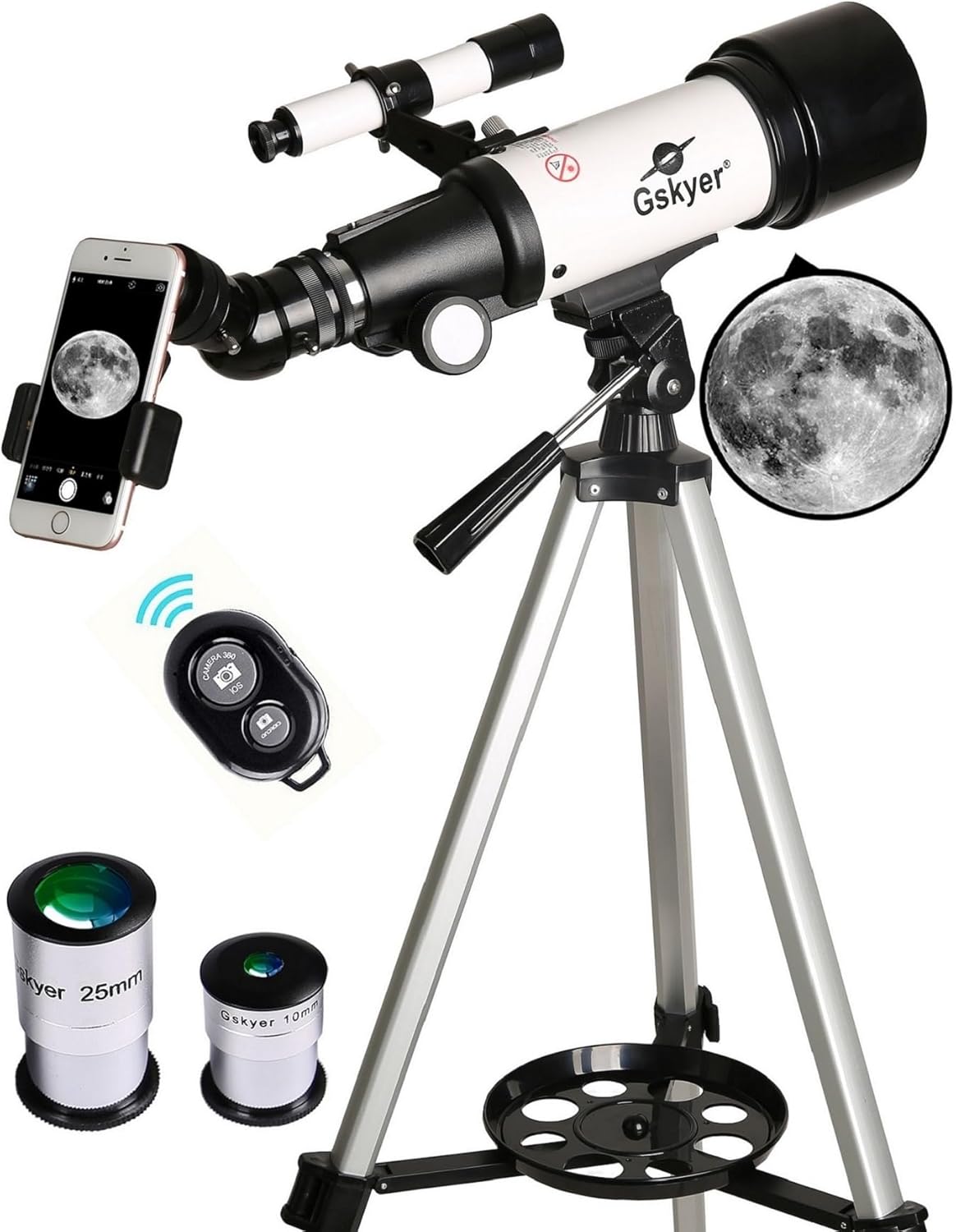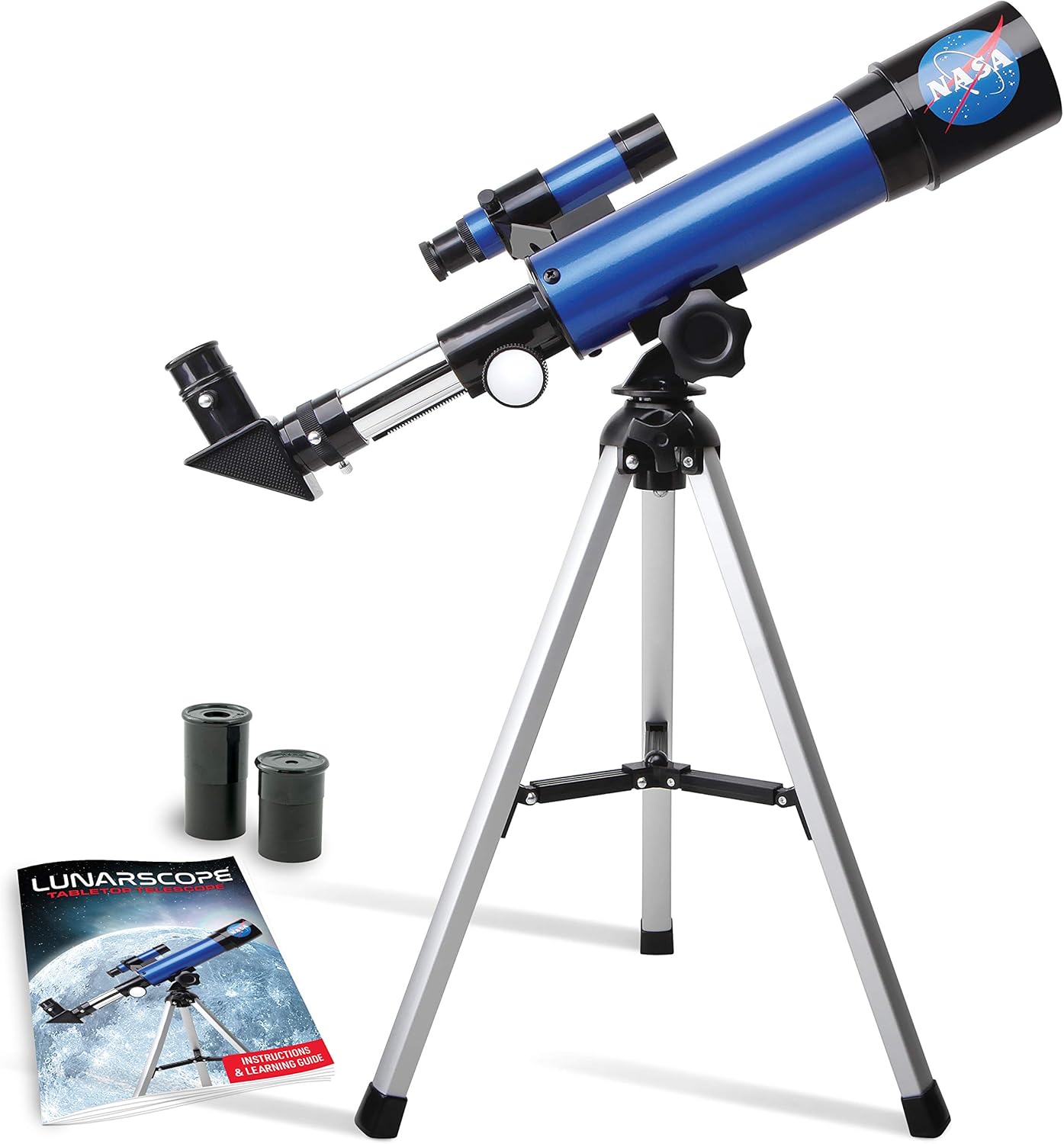Here’s an overview of the Best Telescopes that we’ll explore today:
Top Pick
Gskyer Telescope |
||
Best Quality
NASA Lunar Telescope for Kids – 90x Magnification |
||
Telescope for Adults |
||
Telescope |
||
Telescope |
Telescopes are essential tools for exploring the wonders of the night sky, offering users a window into the cosmos. Whether you’re a beginner stargazer or an experienced astronomer, selecting the right telescope is crucial to ensuring a satisfying experience. In this review, we compare five telescopes across a range of price points ($44.99 to $159.99) and features to help consumers make an informed purchase decision. Our methodology involved hands-on testing, evaluating optical performance, ease of use, portability, and overall value. The products reviewed include budget-friendly options for kids and beginners, as well as premium models for more advanced users. Each telescope was assessed for its ability to deliver clear, detailed images of celestial objects and its suitability for various use cases.
1. Gskyer Telescope
- Brand: Gskyer
- Manufacturer: Gskyer
The Gskyer 70mm telescope is a mid-range option designed for beginner astronomers. With a 70mm aperture and 400mm focal length, it delivers solid optical performance for observing the moon and stars. The telescope includes two eyepieces (10mm and 25mm) and a 3x Barlow lens, enabling magnification versatility. Additional features like the wireless remote and smartphone adapter make it ideal for astrophotography enthusiasts. The adjustable aluminum tripod and carry bag enhance portability and storage, making this a practical choice for on-the-go stargazing.
During testing, the Gskyer telescope impressed with its bright and clear images, thanks to its fully coated optics. The 5×24 finder scope simplified object location, although its crosshair accuracy could be improved. The telescope’s setup was straightforward, but the tripod felt slightly less stable at higher magnifications. This model is best suited for beginners who want a balance of affordability and performance, especially for lunar and planetary viewing. However, deep-sky observation is limited due to the smaller aperture.
Pros
- Fully coated optics for bright and clear images
- Versatile magnification with two eyepieces and 3x Barlow lens
- Includes smartphone adapter and wireless remote for astrophotography
- Portable design with carry bag
Cons
- Tripod stability could be improved
- Limited deep-sky observation due to smaller aperture
2. NASA Lunar Telescope for Kids – 90x Magnification
- Brand: Blue Marble
- Manufacturer: Blue Marble
The NASA Lunar Telescope is a budget-friendly option aimed at young astronomers and beginners. With a 90x magnification, two eyepieces, and a tabletop tripod, this telescope is tailored for lunar observation. Its lightweight design and smooth mount system make it easy to use, while the finder scope helps users locate the moon. The telescope is marketed as an educational tool, inspiring curiosity in space exploration for children.
While affordable, the NASA Lunar Telescope has limitations in optical performance. The 25mm aperture restricts light capture, resulting in dimmer images compared to larger models. The tabletop tripod is compact but lacks height adjustment, limiting viewing angles. It excels as a starter telescope for kids, providing an engaging introduction to astronomy, but users seeking more detailed celestial views may find it underwhelming.
Pros
- Affordable price point
- Easy-to-use design ideal for kids and beginners
- Includes finder scope for locating the moon
- Compact and lightweight for tabletop use
Cons
- Limited aperture results in dimmer images
- Tabletop tripod lacks height adjustment
3. Telescope for Adults
- Brand: HEXEUM
- Manufacturer: HEXEUM
The HEXEUM 80mm telescope offers excellent optical quality at a competitive price. With a 600mm focal length and fully multi-coated lenses, it provides bright and detailed views of celestial objects. The telescope includes two eyepieces (10mm and 25mm), a 3x Barlow lens, and a reflex finder scope, making it easy to locate and magnify objects. The adjustable aluminum tripod, phone adapter, and carry bag enhance portability and convenience, making it suitable for both beginners and intermediate users.
In testing, the HEXEUM telescope delivered impressive performance, particularly for lunar and planetary observation. The 80mm aperture captured ample light, producing sharp and vibrant images. The setup process was quick and tool-free, ideal for novice users. However, the tripod’s build quality could be sturdier for extended use, and deep-sky imaging was less effective due to the aperture size. Overall, this telescope strikes a great balance between affordability and functionality.
Pros
- 80mm aperture for bright, detailed images
- Multi-coated lenses enhance clarity and brightness
- Includes phone adapter and wireless remote for astrophotography
- Portable design with carry bag
Cons
- Tripod stability could be improved
- Limited performance for deep-sky imaging
4. Telescope
- Brand: HUGERSTAR
- Manufacturer: HUGERSTAR
The HUGERSTAR 90mm telescope is the premium option in this comparison, designed for advanced astronomy enthusiasts. Its 90mm aperture and 800mm focal length deliver exceptional optical performance, capturing bright and detailed images of the moon, planets, and stars. The telescope includes two eyepieces (10mm and 25mm), a 3x Barlow lens, and a moon filter for enhanced lunar observation. The stainless steel tripod and carry bag provide stability and portability, while the phone adapter allows users to capture and share celestial images.
This telescope excelled in testing, offering the best optical clarity and magnification range of the models reviewed. The sturdy tripod ensured stable viewing even at high magnifications, and the moon filter reduced glare effectively. Setup was quick and straightforward, making it accessible to beginners despite its advanced capabilities. However, its higher price point may deter budget-conscious buyers. This model is ideal for serious stargazers seeking superior performance for detailed observations.
Pros
- 90mm aperture delivers exceptional optical clarity
- Wide magnification range (32x-240x) for versatile viewing
- Sturdy stainless steel tripod provides stability
- Includes moon filter for enhanced lunar observation
Cons
- Higher price point compared to other models
- Bulky design may limit portability
5. Telescope
- Brand: HUGERSTAR
- Manufacturer: HUGERSTAR
The HUGERSTAR 80mm telescope is a versatile option suitable for children, beginners, and casual astronomers. With an 80mm aperture and 600mm focal length, it offers bright and wide-field views of celestial objects. The telescope includes two eyepieces (10mm and 25mm), a 3x Barlow lens, and a moon filter for improved lunar observation. The lightweight aluminum tripod and carry bag make it portable and easy to set up for backyard stargazing or travel.
During testing, this telescope impressed with its ease of use and image quality. The multi-coated lenses enhanced light transmission, producing vibrant views of the moon and planets. The tripod was stable for casual use, but advanced users may find it less robust for high-magnification observations. This model is an excellent choice for families and beginners seeking a reliable and affordable telescope for general astronomy.
Pros
- Bright and wide-field views with 80mm aperture
- Includes moon filter for improved lunar observation
- Lightweight and portable design
- Easy setup with clear instructions
Cons
- Tripod stability may not satisfy advanced users
- Limited performance for deep-sky imaging
Frequently Asked Questions
We’ve compiled answers to the most common questions about telesopess to help you make an informed decision.
Conclusion
Choosing the right telesopes can truly enhance your game.
It offers convenience and makes walking the course easier. With various options available, it’s important to consider your needs.
Think about the cart’s weight, stability, and storage features. A good push cart can save you energy..





